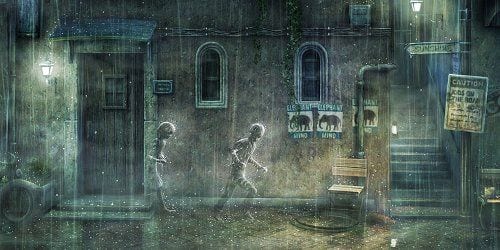
I have a problem with any game that can be accurately described as delightful. Not a material problem though, as I usually like such games. Rather it’s when it comes to talking about the game either in casual conversation, while writing a critiquing of it, or in a review such as this that I find that games that are delightful tend to have little else to be said about them. Rain is just such a game. I can think of no single better adjective to describe it, and yet I am having difficulty in thinking of anything of substance to say in addition to it.
Rain begins by presenting a colorful set of sparsely water color still images that serve to introduce its premise. A boy looks out his window and sees an invisible girl being chased by invisible beasts highlighted only by the rain. He jumps out his window into the street and begins to follow. Once he crosses a barrier, he too finds himself invisible and threatened by the beasts. He is in another realm. The streets of Paris look familiar, but they are empty and the rain is ever present.
Functionally, Rain is a stealth game. Much of it is spent hiding and avoiding the dangers of the invisible beasts. There are numerous methods, everything from the basics of hiding under overpasses or awnings out of the rain, to become invisible, which also include moving slowly to avoid making a sound or deliberately making noise to draw a beast away. In the realm of stealth games, it’s basic and more of an introduction to the genre.
The other main aspect of gameplay is traversal. You will navigate environments by climbing, jumping, and balancing. Occasionally there will be some additional form of interaction like opening a door or moving a crate. Sometimes two or more concepts have to be brought together to overcome a unique obstacle. The lovely thing about Rain is that it doesn’t repeat itself regarding challenges. There is always something new, and the game ends before it runs out of ideas.
There are quite a variety of beasts, each with their own behaviors and abilities. The most notable creature is a large humanoid figure armed with a club or sword-like weapon that follows you for the whole game, tracking you down like a juggernaut. He will act as the main antagonist of the game.
Mechanically it all works perfectly fine. There isn’t anything bad that could be said about Rain on that front. Unless you expect a high level of challenge (something that the game never promises), it will not disappoint.
But that’s not why we are here. Rain is a game that is all about tone. It’s about the visceral impact of its images. The art direction is its draw. The color palette of deep blues, greens, and the occasional strand of orange paint the wet cobblestones and fading Parisian street lamps. For the first few chapters, we are following the girl, always one or two steps behind as she is on her own journey of escape. She does not know the boy exists. But soon they find each other.
We are treated to the light hearted dance of children through the streets in the rain. They run forward in tandem, the girl in front, the boy in front, then side-by-side. They work together, they help each other climb ledges higher than either one could jump to individually. But the pace changes at their meeting, and we are treated to a different tone. The romantic spirit of the city takes hold when the two are out of danger and together at a street side cafe or on a riverside back road. It looks like the playful first date of young people before awkwardness and self-consciousness set in. The closest analog would be the dance among the stars in Wall-E.
Neither the boy nor girl speak. The beasts only roar and chatter as animals do. Everything is communicated through pantomime and subtle animations. A story is told though the musical soundscape that evokes the mood so well that it becomes the core of the game that everything else is there to enhance. A simple test of your own tastes: listen to Claude Debussy’s Clair de Lune. It is the base theme for much of the music in Rain, but it is also a pitch perfect microcosm of the game’s journey on a purely surface level of emotional engagement.
The term fairy tale gets tossed around a lot for fare that is more oriented towards children with, fare that contains a slight fantasy bent. In reality, though, Rain follows the basic premise of the fable. A child taken from his ordinary life and tossed into a situation of danger, yet who will experience a world of wonder before having to return back to his normal life. Nothing is ever explained in Rain. Things just are. The beast is beaten at the very end and his dark world bleeds away in the light, but nothing is learned. Nothing needs to be learned. There is no message or moral. Just two people meeting to have a beautiful experience in one another’s company.
